Buddhist prayer traditions encompass a range of practices that have deep historical and cultural significance. These traditions are rooted in ancient rituals and sacred practices that inspire peace, mindfulness, and spiritual development. From the veneration of the Buddha to the exchange between monks and laypersons, these practices form the foundation of Buddhist prayer rituals across different traditions. Many of these practices remain central to the daily lives of Buddhist practitioners, serving as a means of connecting with the divine and cultivating a deeper understanding of the self and the universe.
Key Takeaways:
- Buddhist prayer traditions have deep historical and cultural significance.
- These practices inspire peace, mindfulness, and spiritual development.
- Veneration of the Buddha and other Buddhist figures is a fundamental aspect of Buddhist prayer rituals.
- The exchange between monks and laypersons strengthens the community and promotes spiritual growth.
- Calendric and festive rituals mark significant events in the Buddha’s life.
Veneration of the Buddha and Other Buddhist Figures
The veneration of the Buddha and other buddhas, bodhisattvas, or saints is a fundamental aspect of Buddhist prayer rituals. This practice involves showing respect, meditating on the qualities of the Buddha, and making offerings to their relics, images, or other sacred representations. Throughout the history of Buddhism, the forms of veneration have evolved, but the central act of honoring and worshiping the Buddha or Buddha figures remains consistent across all Buddhist traditions.
In addition to the veneration of the Buddha Gautama, other buddhas and bodhisattvas are also venerated in Mahayana and Vajrayana traditions. These figures play significant roles in these traditions, often supplementing or replacing the veneration of the Buddha Gautama. The veneration of these figures provides devotees with various role models for attaining enlightenment and cultivating compassion.
Through the veneration of the Buddha and other Buddhist figures, practitioners seek inspiration, guidance, and blessings on their spiritual journey. The act of veneration serves as a focal point for devotion and gratitude, deepening their connection with the divine and fostering a sense of reverence and awe.
Table: Comparison of Buddhist Figures Venerated in Different Buddhist Traditions
| Buddhist Tradition | Primary Venerated Figure | Other Venerated Figures |
|---|---|---|
| Theravada | Buddha Gautama | N/A |
| Mahayana | Buddha Gautama | Amitabha Buddha, Avalokiteshvara, Maitreya, Manjushri, Kuan Yin, etc. |
| Vajrayana | Buddha Gautama | Amitabha Buddha, Avalokiteshvara, Vajradhara, Guru Rinpoche, Tara, etc. |
The veneration of the Buddha and other Buddhist figures is a deeply ingrained practice in Buddhist prayer rituals. It serves as a means for devotees to express their devotion, seek blessings, and draw inspiration from the enlightened beings who embody the highest ideals of Buddhist teachings.
Emphasizing the importance of reverence and devotion, this aspect of Buddhist prayer rituals connects practitioners with the rich spiritual heritage of Buddhism and reinforces their commitment to walking the path of awakening.
Buddhist Meditation and Devotional Practices
Buddhist prayer traditions encompass a diverse range of practices, including meditation and devotional rituals, that are deeply rooted in the philosophy and teachings of Buddhism. These practices serve as important avenues for spiritual growth and self-discovery, allowing practitioners to cultivate inner peace, mindfulness, and a deeper connection with the divine.
One of the integral practices in Buddhist prayer traditions is meditation. Through focused attention and mindfulness, practitioners aim to quiet the mind, cultivate awareness, and develop a sense of inner calm. Meditation is not only a means of relaxation, but also a pathway to self-realization and enlightenment. Buddhist meditation techniques vary across different traditions, such as Zen, Vipassana, and Loving-Kindness meditation, each emphasizing different aspects of the practice.
“Meditation is the self-discovery of inner peace and enlightenment.”
Devotional practices are also an important aspect of Buddhist prayer rituals. These practices often involve making offerings to buddhas, bodhisattvas, and revered figures, as well as reciting mantras and prayers. Devotional rituals can take place in temples, monasteries, or even in personal altars at home. They serve as a way to express gratitude, seek blessings, and deepen one’s connection with the divine.
“Devotional practices are expressions of devotion and reverence towards the enlightened beings.”
Both meditation and devotional practices are considered essential in Buddhist prayer traditions, working in harmony to cultivate spiritual growth, mindfulness, and enlightenment. They provide practitioners with the tools and techniques to navigate the complexities of life, foster compassion and wisdom, and ultimately achieve a state of liberation and peace.

Buddhist Calendric and Festive Rituals
Buddhist prayer traditions encompass a wide range of calendric and festive rituals that hold deep spiritual significance. These rituals are observed throughout the year and provide opportunities for devout practitioners to engage in religious duties, reflect on teachings, and deepen their connection with the divine. Let us explore some of the key calendric and festive rituals that are integral to Buddhist prayer practices.
Uposatha: Monthly Holy Days
One of the prominent calendric rituals in Buddhist prayer traditions is the observance of Uposatha, a term derived from the Pali language meaning “entering upon a path of purification.” Uposatha consists of four monthly holy days, which are traditionally based on the lunar calendar. On these days, Buddhist practitioners come together to observe precepts, offer flowers to the Buddha image, recite Pali suttas (discourses), engage in meditation practices, and listen to sermons delivered by monks.
These Uposatha days are considered sacred and serve as significant periods for spiritual reflection, renewal, and devotion. They offer practitioners an opportunity to deepen their understanding of Buddhist teachings, strengthen their commitment to ethical conduct, and develop mindfulness and concentration through meditation practices.
Annual Buddhist Festivals
In addition to the monthly Uposatha days, Buddhist prayer traditions also encompass a variety of annual festivals that commemorate significant events in the life of the Buddha and other revered figures. These festivals are celebrated with great joy, devotion, and religious fervor, attracting both laypeople and monastic communities.
For example, Vesak, also known as Buddha Purnima or Buddha Day, is widely celebrated throughout the Buddhist world. It commemorates the birth, enlightenment, and parinibbana (death) of the historical Buddha Gautama. During Vesak, devotees engage in acts of generosity, observe precepts, participate in chanting and meditation practices, and make offerings at Buddhist temples and monasteries. Vesak is a time for reflection, gratitude, and deepening one’s understanding of the Buddha’s teachings.
Other festivals such as Magha Puja, Asalha Puja, and Kathina hold significance in various Buddhist traditions and provide opportunities for communal gathering, merit-making, and spiritual renewal. These festivals often involve processions, recitations of sacred texts, and the performance of traditional cultural rituals.
| Festival | Significance | Observance |
|---|---|---|
| Vesak | Birth, enlightenment, and death of the Buddha | Widely celebrated in Buddhist communities worldwide |
| Magha Puja | Spontaneous gathering of 1,250 enlightened monks | Observed in Theravada Buddhist countries |
| Asalha Puja | First sermon delivered by the Buddha | Observed in Theravada Buddhist countries |
| Kathina | Offering of robes to the monastic community | Observed in Theravada Buddhist countries |
Pilgrimage and Sacred Sites
Pilgrimage is a significant aspect of Buddhist prayer traditions, allowing practitioners to visit sacred sites and engage in spiritual practices. In the early years of Buddhism, pilgrimage to places associated with the Buddha’s life, such as Lumbini, Bodh Gaya, Varanasi, and Kushinara, played a central role. Today, major pilgrimage centers have emerged in regions where Buddhism is established, attracting devotees from near and far. Pilgrims engage in rituals such as prostrations, making offerings, and chanting mantras as they circumambulate sacred landmarks. Additionally, sacred mountains and monasteries hold deep religious significance and serve as destinations for spiritual seekers.
One important tool in Buddhist prayer traditions is the use of prayer beads, also known as mala. These beads, typically made from materials such as wood, seeds, or gemstones, help practitioners count the repetitions of mantras or prayers. Each bead represents a prayer or mantra, and the act of moving the beads through the fingers helps maintain focus and concentration during meditation and recitation. Prayer beads serve as a tangible reminder of the practitioner’s devotion and commitment to their spiritual path.
Table: Examples of Sacred Buddhist Sites
| Location | Significance |
|---|---|
| Bodh Gaya, Bihar, India | The site where Siddhartha Gautama, the historical Buddha, attained enlightenment under the Bodhi tree. |
| Lumbini, Rupandehi, Nepal | The birthplace of Siddhartha Gautama, marked by the Mayadevi Temple. |
| Kushinagar, Uttar Pradesh, India | The place where the Buddha entered Parinirvana, or final nirvana, after his death. |
| Sarnath, Uttar Pradesh, India | The location where the Buddha gave his first sermon after attaining enlightenment, known as the Dhammacakkappavattana Sutta. |
“The spiritual journey of a pilgrim is a sacred and transformative experience. It allows individuals to deepen their connection with the Buddha and the teachings, as well as with fellow practitioners. Through pilgrimage, we seek not only to visit sacred sites but also to embody the spirit of the path, cultivating peace, compassion, and wisdom.” – Buddhist practitioner
Overall, pilgrimage and sacred sites hold a special place in Buddhist prayer traditions. They provide devotees with opportunities for introspection, devotion, and communion with the divine. Whether circumambulating a sacred mountain, visiting a revered monastery, or reciting mantras while holding prayer beads, these practices deepen the spiritual journey and inspire practitioners to embody the teachings of Buddha in their everyday lives.

Conclusion
Buddhist prayer traditions encompass a rich tapestry of sacred rituals and practices that offer a profound exploration of spirituality, mindfulness, and devotion. These traditions, deeply rooted in the history and philosophy of Buddhism, provide practitioners with opportunities for personal transformation and a deeper connection with the divine.
From the veneration of the Buddha and other revered figures to the exchange between monks and laypersons, these rituals form the core of Buddhist prayer practices. The act of showing respect, meditating, and making offerings to the Buddha and other figures allows practitioners to cultivate reverence and deepen their spiritual connection.
In addition, calendric and festive rituals throughout the year, such as the uposatha and celebrations of significant events in the Buddha’s life, provide moments of reflection and religious duties. These rituals serve as reminders of the Buddha’s teachings and offer opportunities for self-reflection and growth.
Pilgrimage to sacred sites holds a special place in Buddhist prayer traditions. By visiting places associated with the Buddha’s life and engaging in rituals such as prostrations, offerings, and mantra recitation, pilgrims embark on a spiritual journey seeking enlightenment and deepening their understanding of the Dharma.
Through prayer, meditation, mantra recitation, and various rituals, Buddhist devotees strive to cultivate inner peace, wisdom, and enlightenment. These practices, grounded in ancient wisdom and passed down through generations, continue to inspire and guide practitioners on their spiritual path.
FAQ
What are Buddhist prayer traditions?
Buddhist prayer traditions encompass a range of practices rooted in ancient rituals and sacred practices that inspire peace, mindfulness, and spiritual development.
What is the veneration of the Buddha?
The veneration of the Buddha is a fundamental aspect of Buddhist prayer traditions, involving showing respect, meditating on the qualities of the Buddha, and making offerings to their relics, images, or other sacred representations.
Who else is venerated in Buddhist prayer traditions?
In Mahayana and Vajrayana traditions, other buddhas and bodhisattvas are also venerated, supplementing or replacing the veneration of the Buddha Gautama.
What is the exchange between monks and laypersons?
The exchange between monks and laypersons is an integral practice in Buddhist prayer traditions, strengthening the bond between the monastic community and the laity and promoting spiritual growth and understanding.
What are calendric and festive rituals in Buddhist prayer traditions?
Calendric and festive rituals are various rituals observed throughout the year, such as the uposatha in Theravada countries and festivals honoring buddhas, bodhisattvas, and patriarchs. These rituals provide opportunities for religious duties, reflection, and celebration.
What is pilgrimage in Buddhist prayer traditions?
Pilgrimage is a significant aspect of Buddhist prayer traditions, allowing practitioners to visit sacred sites and engage in spiritual practices such as prostrations, making offerings, and chanting mantras.
How do Buddhist prayer traditions promote personal transformation?
Through prayer, meditation, mantra recitation, and various rituals, Buddhist devotees seek to cultivate inner peace, wisdom, and enlightenment, promoting personal transformation and connecting with the divine.








